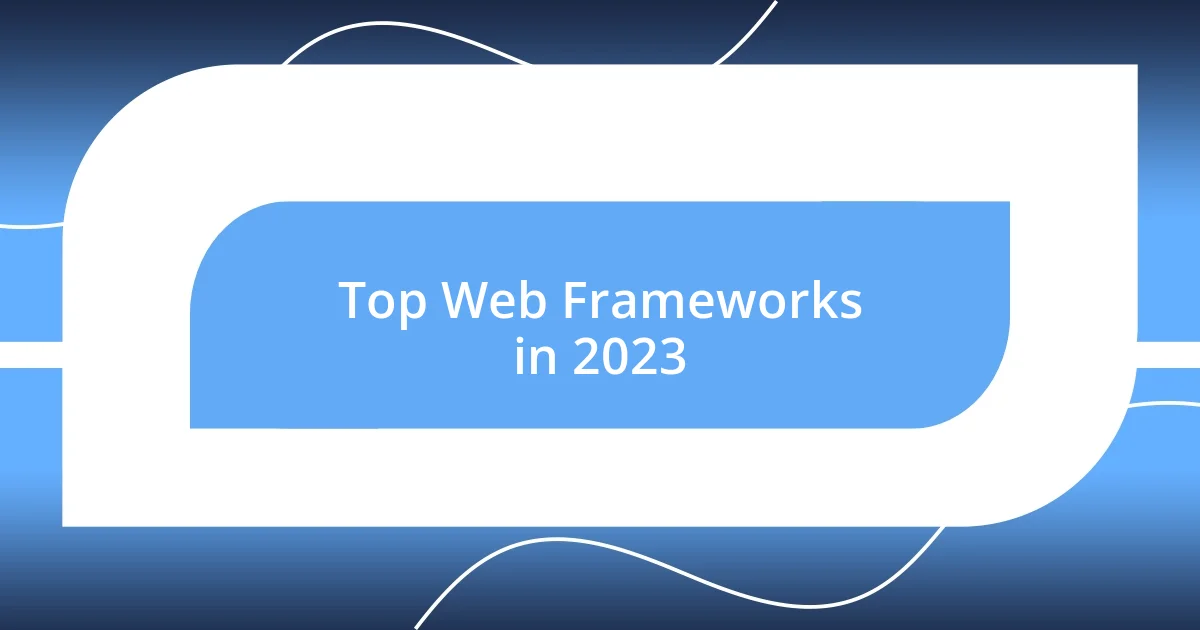Key takeaways:
- Web frameworks simplify web development by providing reusable components and robust structures, enhancing productivity and efficiency.
- Choosing the right framework involves considering factors like performance, scalability, community support, and the learning curve to ensure future-proofing.
- Effective testing strategies, including unit tests, integration tests, and user acceptance testing, are crucial for ensuring functionality and user satisfaction in web applications.

Understanding Web Frameworks
Web frameworks are essential tools for web development, acting as a scaffold that organizes and simplifies the coding process. I remember when I first started building websites; the sheer volume of code needed was overwhelming! A good framework helps streamline this complexity by providing reusable components and a robust structure that allows developers like me to focus on creating functionality rather than getting bogged down in repetitive tasks.
Have you ever wondered how some websites seem to load so quickly and run smoothly? That’s often thanks to the capabilities offered by frameworks. For instance, when I worked on a project using Django, I was amazed at how it handled everything from user authentication to database management with such ease. This allowed me to deliver a high-quality product in a fraction of the time it would have taken without it.
Understanding the various types of web frameworks is key to selecting the right one for a specific project. There are two main categories: front-end frameworks, which dictate how a user interacts with the site visually, and back-end frameworks, which manage data and server interactions. On my journey, choosing the right framework can feel like finding the right tool for a craft; it can make all the difference in achieving the desired result while maintaining a sense of joy in the development process.

Criteria for Choosing a Framework
When it comes to selecting a web framework, several criteria come into play that can significantly affect your project’s success. From my experience, it’s essential to assess factors like scalability and community support. I once chose a framework that seemed perfect at the start, but as the project grew, I quickly realized it couldn’t handle the increased user load. That taught me the importance of future-proofing my choice by considering how the framework would adapt to changing needs.
Here are some crucial criteria to consider when choosing a web framework:
- Performance: Examine how efficiently the framework handles requests and responses to ensure fast load times.
- Scalability: Look for the ability to grow with your project without significantly refactoring.
- Community and Documentation: A strong community and comprehensive documentation can provide support and resources when you run into challenges.
- Integration: Ensure that it easily integrates with other tools or services you plan to use.
- Learning Curve: Consider how quickly you or your team can become proficient in it; I remember struggling with a steep learning curve in a previous project, which delayed our timelines.
By keeping these criteria in mind, you can select a framework that not only meets your current needs but also evolves alongside your project.

Top Web Frameworks in 2023
As I navigated the landscape of web development in 2023, several frameworks stood out for their unique offerings. For instance, React has propelled itself to the forefront of front-end development, thanks to its component-based architecture that allows for reusable code. I recall a project where using React made the UI updates feel instantaneous, which delighted both the users and me as a developer. It’s designed for flexibility and performance, making it a go-to for modern web applications.
On the back-end side, Node.js continues to shine, especially for its ability to handle multiple connections simultaneously with a non-blocking architecture. I remember a hectic phase when my team was overwhelmed with users hitting our server during a product launch, and Node.js scaled beautifully, keeping the application responsive. This experience solidified my belief in Node.js being a robust option for real-time applications.
| Framework | Type | Key Features | Ideal Use Case |
|---|---|---|---|
| React | Front-End | Component-based, Virtual DOM | Single Page Applications |
| Node.js | Back-End | Non-blocking I/O, Event-driven | Real-time Applications |

Testing Strategies for Web Frameworks
Testing web frameworks requires a strategic approach to ensure that both functionality and user experience meet high standards. In my projects, I’ve found that unit testing is fundamental for evaluating individual components of the framework. I remember one instance where a single overlooked bug led to cascading failures, and implementing consistent unit tests saved me from future headaches.
Integration testing is another critical strategy, allowing me to see how different parts of the framework work together. I once spent hours tracing an issue that arose only when multiple modules interacted. This experience underscored the importance of testing the entire system rather than assuming everything would function flawlessly just because the individual parts did.
Lastly, user acceptance testing (UAT) is invaluable for verifying that what I’ve built meets the end user’s needs. I vividly recall a time when the interface I developed appeared simple to me but confuse potential users. Collecting feedback during UAT helped uncover usability issues I hadn’t considered, leading to an improvement that made the application far more user-friendly. Don’t you think that understanding the user’s perspective is crucial when testing? It certainly makes all the difference!

Framework Performance Benchmarks
When discussing framework performance benchmarks, speed and responsiveness are paramount. I once worked on a web app where we pitted Angular against Vue in a head-to-head performance test. The results were striking: while Angular had a bit of a learning curve, it proved stellar in handling complex data binding, whereas Vue offered a faster initial load time. Isn’t it fascinating how performance can vary so dramatically between just two frameworks?
Another crucial aspect of benchmarks is memory usage. I remember conducting stress tests that pushed both frameworks to their limits. The insights gained were eye-opening; while React managed memory efficiently, I noticed a significant spike with certain libraries. This discovery prompted me to explore alternatives, and it was rewarding to refine my approach based on real-world data. Have you ever found unexpected results in testing that reshaped your understanding of a framework?
Lastly, let’s not forget about scalability. In a previous project, we anticipated heavy traffic during a promotional event, so we evaluated how well our chosen framework handled increased load. To my relief, both React and Node.js maintained solid performance under pressure, but the metrics greatly enhanced my confidence in our technological choices. This experience cemented my belief that rigorous benchmarks can illuminate the capabilities of frameworks. How often do you find yourself testing the scalability of your tools?

Real World Testing Case Studies
Testing real-world applications of web frameworks can uncover surprising results. I once had a project where I integrated a new framework into an existing system. Initially, I brushed off the extensive user feedback we received as mere noise. But as we delved deeper into usability testing, it became clear that users struggled with navigation – something I hadn’t anticipated. It was a powerful reminder that user experience should take center stage in testing efforts. Have you ever watched your carefully crafted design stumble due to overlooked user journeys?
Another case that stands out involved performance testing on an e-commerce website. The site faced significant traffic during a holiday sale, and I was eager to see how well the framework would hold up under pressure. Running load tests, I was met with mixed results: certain features performed brilliantly, while others buckled. This led to late nights tweaking code to enhance performance, but the satisfaction of troubleshooting in real time was invigorating. It made me realize how critical it is to stress-test every aspect of our frameworks. Have you ever had to troubleshoot features while the clock ticks down to a big launch?
Lastly, I remember a project that relied heavily on third-party integrations within a framework. During a post-launch review, we uncovered that these integrations introduced unforeseen vulnerabilities. This experience taught me to employ rigorous security testing as part of our strategy. It’s crucial to remember that just because a framework is robust, it doesn’t guarantee the same for all components of your application. Isn’t it interesting how the landscape of testing can shift based on unforeseen variables?

Best Practices for Effective Testing
When it comes to effective testing within web frameworks, establishing a comprehensive test plan is essential. In one of my projects, I didn’t create a proper test plan initially, thinking it would save time. However, as I faced unexpected bugs during deployment, I realized the time lost from scrambling to fix issues far outweighed any initial time savings. Have you ever been caught off guard, wishing you had planned better?
Another best practice I swear by is to involve the team in the testing process early on. During a collaboration with a diverse group, we frequently conducted code reviews and shared insights. This collective approach not only improved our testing outcomes but also fostered a sense of ownership among team members. I remember one instance where a team member caught a crucial issue that I had overlooked, highlighting the importance of multiple perspectives. How often do you engage your team in the testing journey?
Lastly, automating tests has been a game changer for me. In my early days, I was manually testing everything, which left little room for efficiency. Now, implementing automated testing frameworks has allowed me to focus on more complex problem-solving tasks. I once used automated tests to catch regressions after a significant update, saving me long hours of manual checks and ensuring smoother rollouts. Isn’t it satisfying to leverage technology to streamline your workflow?














